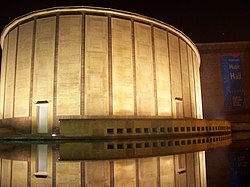Shea’s Buffalo Theater, Main Street, Buffalo, NY
The theater’s exterior is clad in red and cream brick to the sides and rear, with terra cotta and green marble on the principal facade. The rear facade, along Pearl Street, is clad in cream brick with a large arched faux window panel made of terra cotta above the bronze doors and small marquee, which provide access to the building’s lobby immediately outside the theater, with stone and terra cotta cladding at the base of the facade, a large metal fire escape for the theater’s balcony mounted to the exterior, circular reliefs with shields above, and a terra cotta cornice at the top of the building. The theater’s fly tower and stage were expanded in a renovation under the direction of Kideney Architects in 1997-1999 to add more room for live performance equipment and sets, along with a new backstage wing with a loading dock, small punched opening windows, and red brick cladding on the north side of the theater, encroaching on the former Greyhound Bus Terminal next door, and creating a small, mostly enclosed courtyard between the two buildings. The front facade features a lower two-story commercial wing clad in terra cotta with retail shopfronts on the first floor, large Chicago-style windows on the second floor with metal mullions, a parapet with a renaissance gable in the middle above the entrance to the second-story spaces and near the north end, which supports a sign for the Shea’s Smith Theater, a smaller venue now located within this section of the complex. At the south end of the principal facade is the main entrance to the theater, which features green marble panels flanking the bronze doors at the base, with the words “The Wonder Theatre” on the large transom above, and bronze display cases for show posters and advertisements on either side of the doors. Above this is a large marquee with decorative trim at the top, a lot of exposed lightbulbs, large lettering, decorative brackets that flank reliefs with fleur-de-lis, and digital signs on the north and south sides that are easily visible along Main Street to advertise shows and performances at the theater. Above the marquee is a massive three-story curtain wall in an arched opening, flanked by decorative terra cotta relief panels and trim, with three smaller one-over-one windows at the south end of the facade behind the iconic and massive blade sign, which features a lot of lightbulbs, and is a 2004 reproduction of the original blade sign, which was replaced in 1942. The top of the building features a decorative frieze with urns, vines, and a fleur-de-lis in the central panel, a cornice with dentils, and a parapet with acroterons at the ends, a broken pediment with volutes, a carved face in the middle and rosettes, and a decorative finial at the top.
The interior of the theater is lavishly decorated and has a similar layout and similar features to many of the other Rapp and Rapp theaters. This includes, in the lobby, marble pilasters separating arched bays with mirrors and decorative draperies, original Louis Comfort Tiffany chandeliers and wall sconces, ceilings with murals and painted beams, archways surrounded by decorative trim, decorative brass railings at the stairs and balconies, carpeted floors, and ornate decorative plasterwork. The vestibule housing the ticket booth features walls clad in green marble, a decorative plaster ceiling, bronze radiator grilles on the side walls, an arched transom over the doors to the lobby, decorative plasterwork around the top of the walls, and a freestanding octagonal ticket booth in the middle of the space with a green marble lower portion, decorative wood trim around its plate glass windows, urns at the corners of the roof of the ticket booth, and small chandeliers. The auditorium features many of the same elements as the lobby, with features unique to the space within the building including a large proscenium stage, domed ceilings above and below the balcony, Spanish Baroque styling on the ceiling and walls, arches with decorative trim and large oxeye bays containing mirrors, a Wurlitzer pipe organ, and a reproduction Tiffany curtain that matches the original design of the auditorium, but had been substituted for a Rapp-designed curtain when the theater opened.
The theater was listed on the National Register of Historic Places in 1975 to help facilitate its preservation. Between 2000, when the Shea’s O’Connell Preservation Guild, Ltd. was deeded the theater, and 2014, the theater and its interior were fully restored and the building’s systems modernized, and allowing the building to become a fully-featured Performing Arts Center, anchoring the theater district along Main Street in Downtown Buffalo.Relevante Bilder
Relevante Artikel
BuffaloBuffalo ist mit 278.349 Einwohnern (2020) die zweitgrößte Stadt des US-Bundesstaates New York. Mitte des 20. Jahrhunderts hatte sie 0,6 Millionen Einwohner und war im Zensus von 1950 die fünfzehntgrößte Stadt der USA. In der Metropolregion Buffalo-Niagara leben über 1,1 Millionen Einwohner. Buffalo ist Verwaltungssitz des Erie County und liegt an der Nordostspitze des Eriesees nicht weit von den Niagarafällen entfernt. Heute ist Buffalo eine moderne Industrie- und Hafenstadt. .. weiterlesen





















